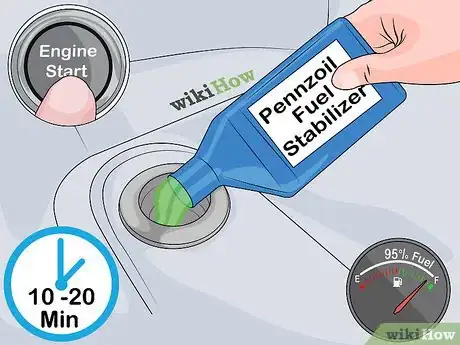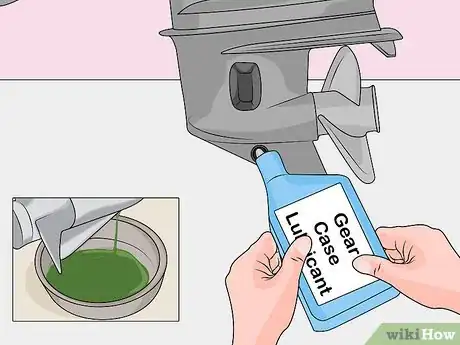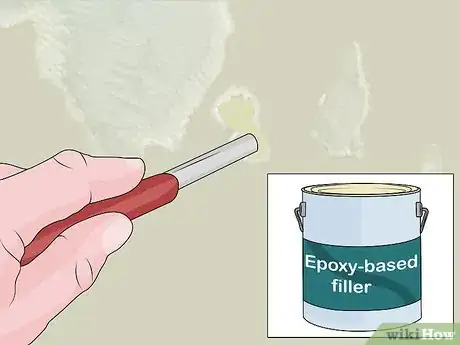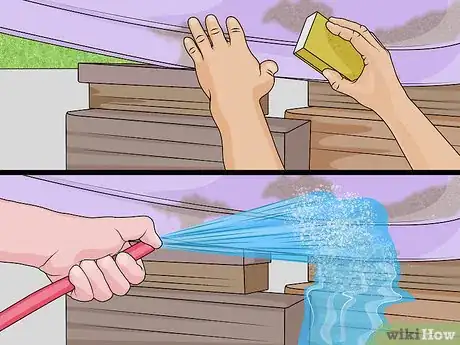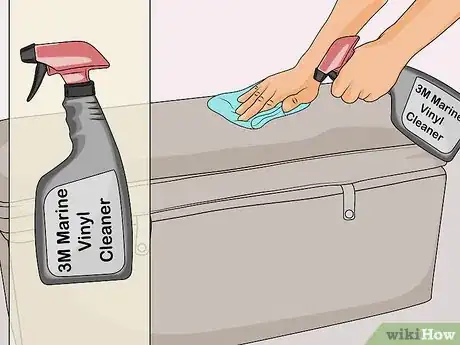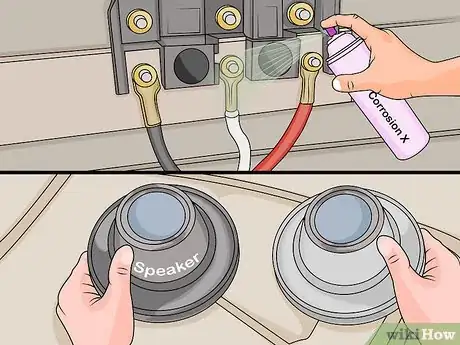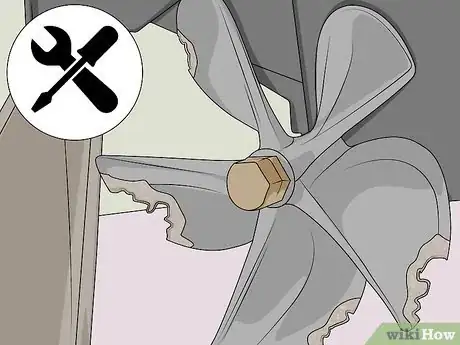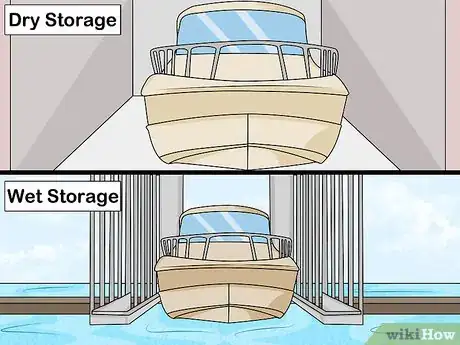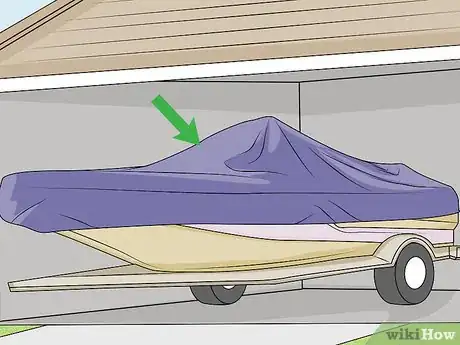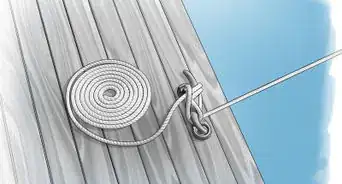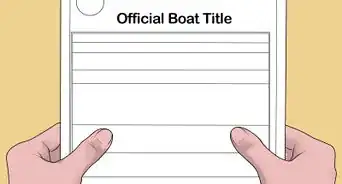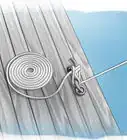This article was co-authored by wikiHow staff writer, Megaera Lorenz, PhD. Megaera Lorenz is an Egyptologist and Writer with over 20 years of experience in public education. In 2017, she graduated with her PhD in Egyptology from The University of Chicago, where she served for several years as a content advisor and program facilitator for the Oriental Institute Museum’s Public Education office. She has also developed and taught Egyptology courses at The University of Chicago and Loyola University Chicago.
There are 9 references cited in this article, which can be found at the bottom of the page.
This article has been viewed 213,066 times.
Learn more...
When the sun sets on another boating season, it is time to get your boat ready for the cold winter months. Taking the necessary steps to winterize your boat will safeguard the vessel and its motor against the elements, so it is ready to use when the warm weather arrives. In order to prepare your boat for winter, you must properly winterize the engine, clean the boat and do any necessary repairs, and store your boat in a manner that will protect it from the elements and preserve your investment. Make sure to follow all steps.
Steps
Winterizing Your Engine
-
1Flush the engine with fresh water. This process will flush salt, dirt, and other contaminants out of your engine in order to prevent blockages and corrosion. Depending on what kind of motor you have, there are a variety of ways to perform a flush.[1]
- For older outboard motors, get a pair of boat engine “ear muffs” and attach them to the water intakes on your engine. Attach a water hose to the opening on the ear muffs, turn on the water, and let the engine run in neutral until the water runs out clean.
- Some newer outboard motors have built-in water hose attachments and a flushing system that can be used without running the engine. If you have this type of motor, you can attach a hose directly to the motor and let the water run for about 10 minutes. Check your owner’s manual, if you have one, for the correct flushing procedure.
-
2Stabilize your fuel. Unstabilized fuel can degrade during the winter, causing gummy buildups that can clog up your engine supply lines. Fill your gas tank with fuel to about 95% of your tank’s capacity. [2] Add a gasoline stabilizer, like Pennzoil Fuel Stabilizer, PRI-G, or Stabil. Follow the directions on the stabilizer packaging to determine the appropriate amount to add. Run your engine for 10-20 minutes after adding the stabilizer in order to distribute the stabilized fuel.[3]
- Alternatively, you can drain your gas tank and supply lines completely and leave your tank empty over the winter.[4]
Advertisement -
3Fog the engine cylinders and carburetor intakes. Coating the inside of your engine with fogging oil will help prevent corrosion. Check your owner’s manual or engine manufacturer’s instructions to determine the best type of fogging oil to use and the proper procedure for fogging your engine.[5]
- For some types of engines, you can simply spray fogging oil into the engine air intake while it is running. Spray a generous amount of fogging oil into the intake, then disconnect the fuel line. Continue spraying fogging oil into the air intake and allow the engine to continue running until it dies. The engine will probably put out a lot of white smoke during this process.
- Alternatively, if you have completely drained the fuel from your engine, you can remove the spark plugs and spray fogging oil directly into the spark plug holes. Spin the engine by hand several times to coat the spark plugs. Put the plugs back in but do not connect the wires. This will keep your boat's pistons from being subjected to air, dampness and other caustic materials when not in use.
-
4Flush your engine block with antifreeze. Using antifreeze will prevent damage that can result from water freezing in your engine block. Antifreeze containing propylene glycol is environmentally friendly and recommended by nearly all manufacturers. Use the highest concentration of antifreeze available (-100). The procedure will differ depending on whether you have an inboard or outboard motor.
- If you have an outboard motor, you can connect an antifreeze kit to your engine’s water intake after flushing with fresh water. Leave your engine running after performing the fresh-water flush, disconnect your water hose, and connect a hose attached to a tank of antifreeze to your water intake instead. Let the engine run while connected to the antifreeze tank until the tank is empty.[6]
- For an inboard motor, take a large bucket of antifreeze (usually about five gallons) and insert the end of the water intake hose from the seacock into the bucket. Let the motor idle until you see antifreeze coming out of the exhaust outlet for at least 30 seconds. Replace the intake hose in the seacock.[7]
-
5Change the oil. If you have an inboard motor, you should change the oil in your engine and transmission. This works best right after running the boat, while the oil is still hot. Hot oil flows more easily, and any contaminants or impurities will be suspended, making it easier to remove them. This is also a good time to replace your oil filter.[8]
- Check your owner’s manual for recommendations on which type of oil to use. Engine oil is available in a variety of viscosities and service ratings, and different engines require different oil properties.
- If you can, drain the old oil by removing the sump plug and allowing the oil to run out into a drainage pan or a cardboard box lined with a garbage bag.
- If this method is not convenient, you can pump the old oil out with a hand pumped or electric oil extractor. Some oil changing devices can both extract the old oil and refill your crankcase with fresh oil.[9]
- Dispose of your used oil at a recycling facility.
-
6Drain and replace the gear case lubricant. This will flush out water and other contaminants that can cause rusting and corrosion. Get your engine hot before draining your gear case lubricant, as this will help the lubricant flow more easily and stir up any settled contaminants.[10]
- If the lubricant looks cloudy or if you see metal shavings suspended in it, it may be time to get your gear case serviced.
-
7Disengage the battery and store it in a safe, dry place for the winter. The battery should be fully charged when put away. Retain the charge and maintain the water level while the battery is in storage.
Cleaning and Maintaining Your Boat
-
1Check your hull for stress cracks and blisters. If you see any cracks in your hull, these may be indicative of a more serious problem and should be evaluated by a professional. If you find blisters in the gel coat on your hull, puncture them, drain out any water, and patch them with an epoxy-based filler like West System or West Marine Gelcoat Repair Kit.[11]
-
2Clean the bottom of your boat. If you have scum and barnacles adhering to the bottom of your boat, you may wish to use a scraper to remove the barnacles and a pressure washer to blast off dirt and scum.[12] If you choose to do this, be conscientious about local laws governing boat pressure washing procedures.[13]
- You can prevent future scum buildup by treating the bottom of your boat with boat wax (such as 3M Marine Ultra Performance Paste Wax).[14]
-
3Clean the interior of your boat. Use a gentle all-purpose cleaner to wipe down interior surfaces and get rid of grime. If necessary, vacuum and wash any carpets.[15]
- If your boat has any interior vinyl components, treat them with a vinyl cleaning and protection solution like 3M Marine Vinyl Cleaner.
- Remove any obvious mold and mildew with a mildew cleanser, such as Star Brite Mildew Stain Remover.
-
4Protect your electronics and electronic fixtures. Remove whatever electronics you can and store them in a dry environment. Spray any exposed electronic fixtures with a moisture displacing lubricant, like Corrosion X or WD-40.[16]
-
5Inspect your vessel's propeller and hub. Look for dented or bowed blades and widespread wear. Change damaged parts and perform needed repairs when winterizing your boat.
Storing Your Boat
-
1Decide between wet or dry storage. Dry storage may ultimately be less expensive than storing your boat in the water, and dry-stored boats are less likely to develop blisters on their hulls. However, dry-stored boats may be more susceptible to damage from sudden freezes than boats stored in the water. Consider your local climate and discuss your options with boating experts in your area.[17]
-
2Store your boat in a climate-controlled setting, if possible. You may wish to rent a climate-controlled storage unit, store your boat in a heated garage on your property, or store your boat in a dry-stacking facility. These options will help protect your boat from the elements, and may be especially important in areas where hurricanes and winter storms are a concern.[18]
-
3Cover your boat. This is a good idea even if the boat will be stored in a heated garage or another type of storage facility. Your cover should be tight fitting, waterproof, and strong enough to hold up if snow or debris falls on it. Whichever type of cover you choose should be well ventilated to prevent trapped moisture inside your boat.[19] A few popular types of boat coverings are:[20]
- Shrinkwrap. The major downside to shrink wrap is that it can trap moisture and lead to mildew if not properly treated and ventilated.
- Custom fabric covers. While the up-front cost of a fabric cover may be high, it can be re-used for many years, and will ultimately cost you less than repeated applications of shrink wrap. Fabric covers also have the advantages of being well-ventilated and easy to remove and replace.
- Polyethylene tarps. Tarps are a fairly inexpensive boat covering solution, but the tarp you select should be thick, and must be supported to prevent damage to your boat from accumulation of snow and debris. You may need to build a frame out of wood or PVC pipe that can be fitted over your boat to support the tarp cover.[21]
Community Q&A
-
QuestionHow can I winterize my Mercury Cruiser engine with antifreeze?
 Community AnswerThe exact procedure that you should follow to winterize an engine may vary depending on your engine's specifications. Check your owner's manual or consult an expert at a local marina or boating supply store to find out the best way to proceed with your specific engine type.
Community AnswerThe exact procedure that you should follow to winterize an engine may vary depending on your engine's specifications. Check your owner's manual or consult an expert at a local marina or boating supply store to find out the best way to proceed with your specific engine type. -
QuestionIs the engine supposed to be in the down position when a boat is winterized?
 Community AnswerYes. The motor will be in the down position, but removed from the boat and stored in a shelter, out of the elements. Using a fuel additive just prior to the last running of the motor increases its survival over the winter months.
Community AnswerYes. The motor will be in the down position, but removed from the boat and stored in a shelter, out of the elements. Using a fuel additive just prior to the last running of the motor increases its survival over the winter months. -
QuestionDo all boats need oil changes?
 Community AnswerJust like cars, boats need to have their oil changed. Four-stroke outboards, inboards and stern drive boats require regular oil changes. The frequency will vary by model but a good rule of thumb is to change the oil every 100 hours of operation or once a year.
Community AnswerJust like cars, boats need to have their oil changed. Four-stroke outboards, inboards and stern drive boats require regular oil changes. The frequency will vary by model but a good rule of thumb is to change the oil every 100 hours of operation or once a year.
Warnings
- Do not disconnect the battery if your boat stays in the water during the winter.⧼thumbs_response⧽
- Fogging oil is gummy and may stick to an injector if your boat has a fuel-injected engine.⧼thumbs_response⧽
Things You'll Need
- Fuel
- Gasoline stabilizer
- Fogging or two-cycle oil
- Boat cover
- Antifreeze kit
- Garden hose
- Engine ear muffs
- Drainage pan
- Oil extractor/oil changer
- Pressure washer
- Gentle all-purpose cleanser
- Vinyl cleaner and protectant
- Soft sponge or washcloth
- Moisture displacing lubricant
- Mildew treatment
- Owner's manual
References
- ↑ http://www.boatus.com/magazine/2013/August/outboard-flushing-the-right-way.asp
- ↑ http://www.boatus.com/boattech/casey/winterizing-your-engine.asp
- ↑ http://www.popularmechanics.com/adventure/outdoors/a184/1276866/
- ↑ http://www.boatus.com/boattech/casey/winterizing-your-engine.asp
- ↑ https://www.westmarine.com/WestAdvisor/Winterizing-Your-Outboard-Motor
- ↑ https://www.westmarine.com/WestAdvisor/Winterizing-Your-Outboard-Motor
- ↑ https://www.westmarine.com/WestAdvisor/Winterizing-your-Gas-Inboard-or-Sterndrive
- ↑ http://www.boatus.com/boattech/casey/winterizing-your-engine.asp
- ↑ https://www.westmarine.com/WestAdvisor/DIY-Changing-Engine-Oil
- ↑ http://www.boatingmag.com/top-winterizing-tips#page-18
- ↑ http://www.popularmechanics.com/adventure/outdoors/a184/1276866/
- ↑ http://www.popularmechanics.com/adventure/outdoors/a184/1276866/
- ↑ http://www.ct.gov/deep/lib/deep/long_island_sound/clean_marina/clean_marina_pdfs/hauling_storing_pdfs/pressure_washing_08.pdf
- ↑ http://www.popularmechanics.com/adventure/outdoors/a184/1276866/
- ↑ http://www.popularmechanics.com/adventure/outdoors/a184/1276866/
- ↑ http://www.popularmechanics.com/adventure/outdoors/a184/1276866/
- ↑ https://www.westmarine.com/WestAdvisor/Storing-Your-Boat
- ↑ https://www.westmarine.com/WestAdvisor/Storing-Your-Boat
- ↑ http://www.popularmechanics.com/adventure/outdoors/a184/1276866/
- ↑ https://www.westmarine.com/WestAdvisor/Storing-Your-Boat
- ↑ http://www.popularmechanics.com/adventure/outdoors/a184/1276866/
About This Article
To winterize a boat, flush the engine with fresh water to get rid of any contaminants. You should also fill up the gas tank almost all of the way and add a gasoline stabilizer so the fuel in your boat doesn't degrade over the winter. Also, coat the engine cylinders and carburetor intakes with fogging oil to protect them from corrosion. You'll also want to flush the engine block with antifreeze, change your boat's oil, and replace the gear case lubricant. To finish winterizing your boat's engine, remove the battery and store it in a safe place over the winter. To learn how to clean your boat before winter, scroll down!

